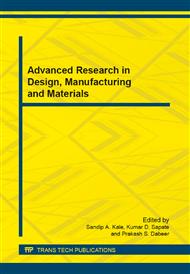p.111
p.117
p.123
p.131
p.139
p.145
p.151
p.157
p.163
Experimental Optimization of Thickness of Protective Padding for Two-Wheeler Rider’s Helmet
Abstract:
Helmet protection to vulnerable two wheeler riders presents many challenges including those of weight, ergonomics appearance and convenience. Safety provided to a two wheeler riders head is mainly dependent on the level of shock getting propagated to the brain during the accident situations and therefore the design of the layer of shock absorbing padding assumes great importance. This padding, generally made of expanded polystyrene (EPS) or of state of art materials needs to be optimized. Helmets prototypes using an external hard shell made of Fiber Reinforced Plastic (FRP) were built to the different thicknesses and impact absorption tests on different types of test rigs were conducted
Info:
Periodical:
Pages:
139-143
Citation:
Online since:
August 2014
Authors:
Price:
Сopyright:
© 2014 Trans Tech Publications Ltd. All Rights Reserved
Share:
Citation:


